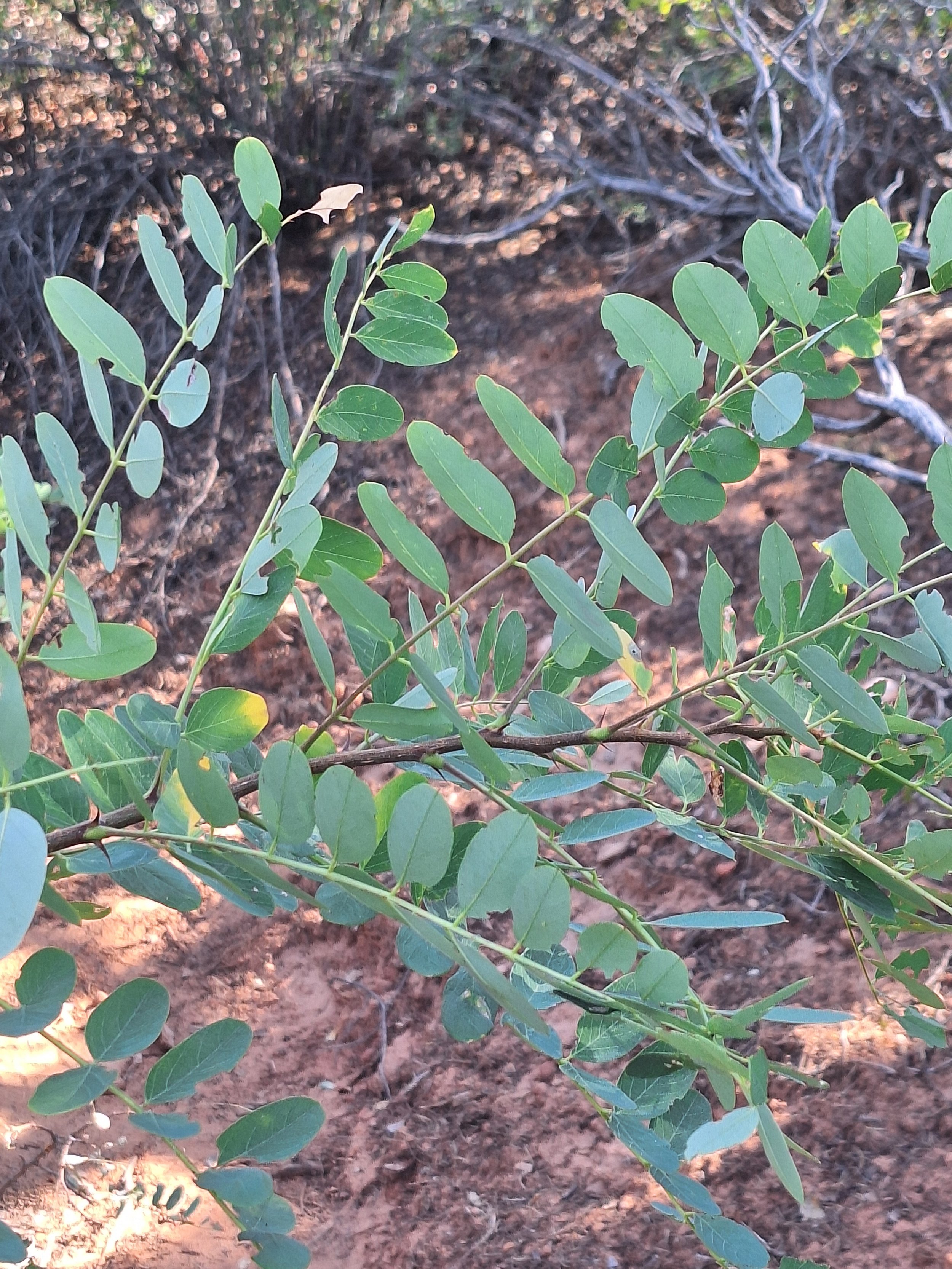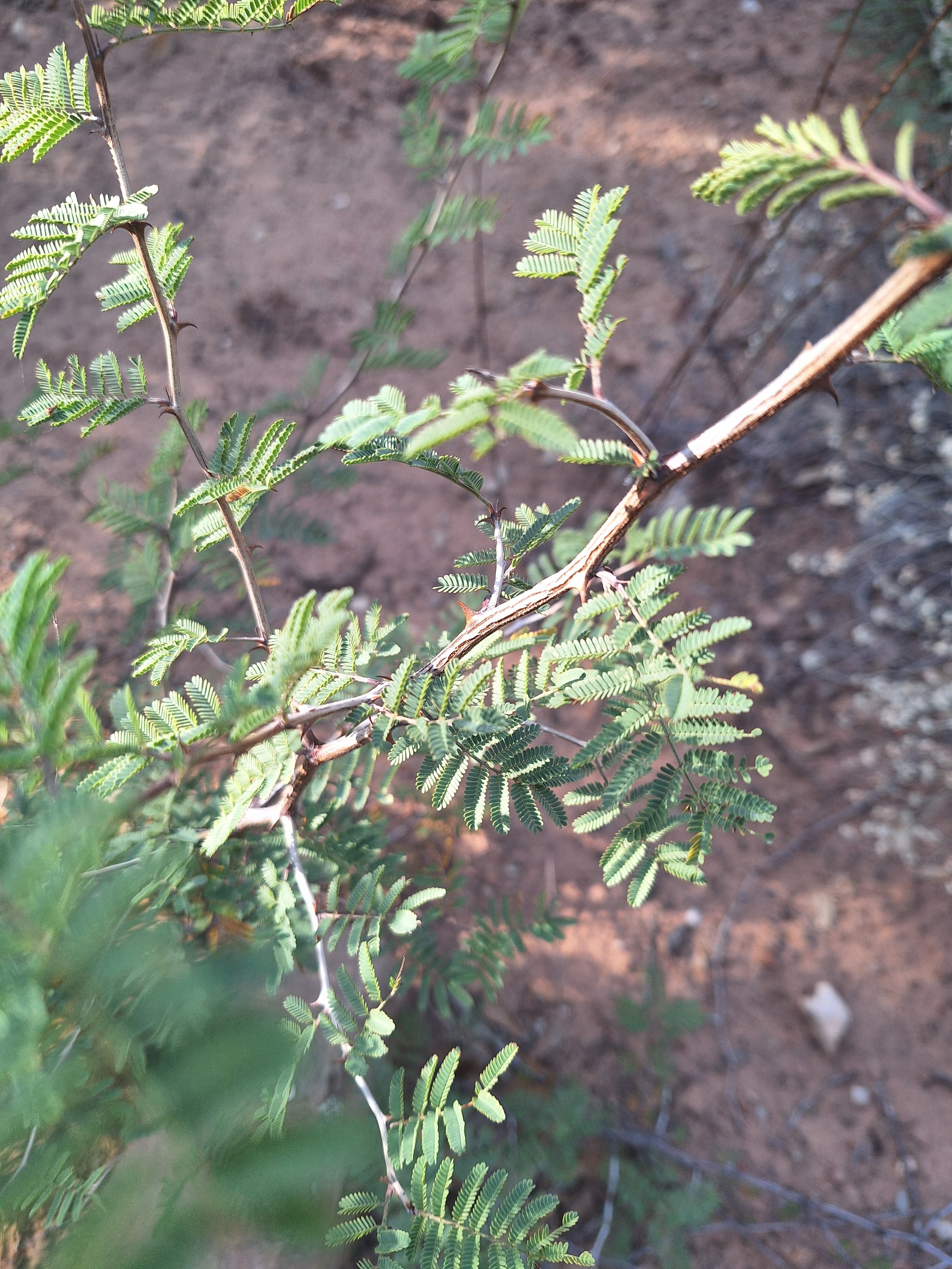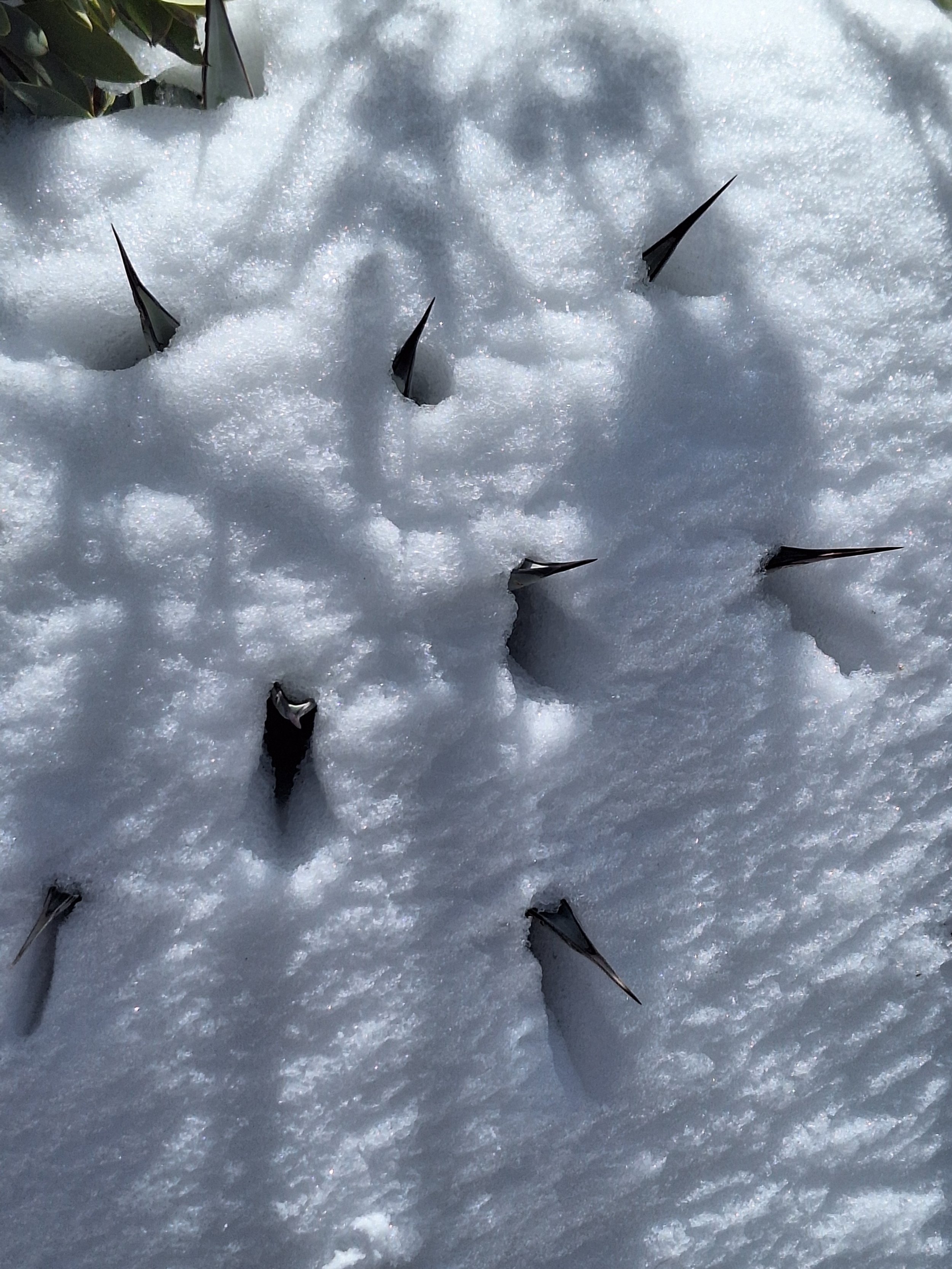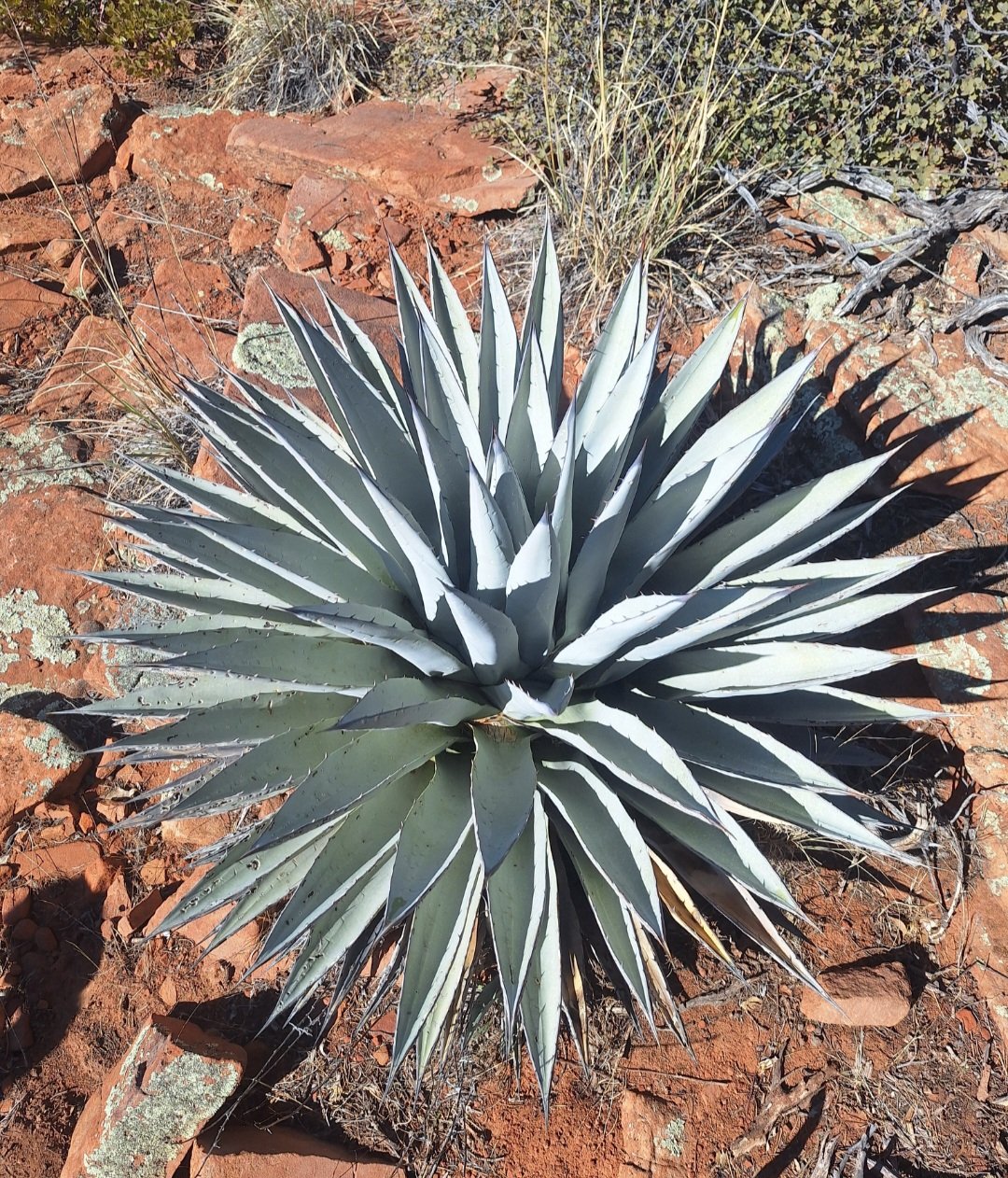
Arizona Black Tail Rattlesnake. Photo by Eric Moorcroft

Almond shaped leaves distinguish the New Mexican Locust.

Catclaw is perhaps the most annoying of Sedona vegetation and has earned its' name.

The Parry's Agave A.K.A. Cowboy Killers, hiding under the snow.

The Parry's Agave A.K.A. Arizona Agave is the deadliest of the local vegetation.

AZ Black-tailed rattlesnake. Photo by Shane Bezzant

An agave tip likely to require surgical extraction.
Dangers
When traveling in the front and back country it is helpful to consider certain dangers you may encounter. With increased awareness of risks and dangers specific to Sedona Canyoneering, adventurers can better prepare for a safe and enjoyable experience.
“ By failing to prepare, you are preparing to fail.” - Ben Franklin
Situational Awareness is key to being safe and successful in the outdoors. I have experienced most of my oops, uh-oh’s, and oh no’s due to poor judgement or decisions made as a result of not being completely aware of my surroundings. Every action (especially in canyon) has a result. From taking a step on the approach, to handing off a pack, or rigging a rappel, and that is why it is important to stay aware of what is going on around you.
Preventable causes of poor situational awareness:
Hunger, Exhaustion, Dehydration
Discomfort- Being too cold or too hot
Large groups
Pictures/ Cell phones
Heat
Dehydration- During warmer months dehydration is a common risk, and it is important to plan how much water you will need to stay fully hydrated. Water is NOT available at the trailheads. Keeping a supply of electrolytes in your pack could be beneficial during hotter months.
(1+) Liter: 2-4 hours
(2+) Liters: 4-8hours
(3+ ) Liters: Full Day or Jun, Jul, Aug
Heat Exhaustion- Sun exposure and dry heat during the hotter months is often underestimated resulting in dehydration, exhaustion, and heat stroke. Stopping in the shade every 30 minutes or so for just a few minutes to cool down and drink water will keep your temperature down.
***A sun hat, UPF or sun blocking attire, and small mister/spray bottle will be elements of luxury on those exposed approaches.
Local Tip: Starting early on summers days to knock out big routes helps to beat the heat on the approach, and be in the canyon shade during the hottest part of the day.
Nature
Plants- With an abundance of cacti, agave, and scrub oak it’s important to stay aware, tread lightly, and become familiar with the vegetation.
Protective layers and a set of tweezers will certainly come in handy.
Parry’s Agave- Also known as “Cowboy Killers” or the Century Plant. These are the unarguably the most fierce and dangerous vegetation in the area. These succulents stand from ankle to knee height and have sharp black needle like tips, that often require surgical extraction.
*** Fun Fact: “Century” plants actually live for 25-40+ years before their stalks rise, they bloom, and then die.
Wildlife- During wildlife encounters it is recommended to give the animals their space. Most accidents involving wildlife can be prevented by respecting the animal and its environment and leaving it be. Wildlife are more likely to be encountered shortly after sunrise. Avoid feeding, touching, or disturbing wildlife.
Common encounters: Ants, Bees, Snakes, Scorpions, Deer, Javelina, Coyote, Bobcat
Rare encounters: Bobcat, Mountain Lion, Bear
People
Other hikers and off trail recreationalists are always around and potentially one of the most common, yet overlooked hazards. If starting a canyon early, you will be shocked by the buzz of tourists on your hike out. For the safety and wellness of all, it is important to be considerate of other outdoorsman. It is fair to assume that recreationalists share different codes of outdoor ethics. Other hikers and recreationalists may present additional risks such as rock fall from above, or accidents on the trail. It is our responsibility to set the example and be safe stewards of the area.
Preventing Accidents-
Make yourself seen or known
Announce all rock fall and rope deployment
Trail the rope to the edge to a clear drop
Use extra caution on the last rappel
Rock Fall
Rock fall happens fast, and is often triggered by heavy rains or long thaws where the land becomes saturated. Off trail approaches on steep terrain increase the chances of rockslides, dislodged boulders, and bouncing pebbles. If you spend enough time in the outdoors you will likely encounter all types of rockfall and probably know how to prevent it and what to do if and when it happens.
Preventing Rock Fall- Traveling on durable surfaces such as established trails or solid rock is an effective way to prevent rock fall. When traveling in groups it helps to stay on the same path, give each other space, and point out potential hazards. Monitoring local weather conditions and precipitation gauges for recent increases in precipitation levels will help you safely plan your adventure. Avoid approaches that have mandatory rock slide gullies especially after a prolonged period of heavy rains.
What to do- The best thing to do when encountering rock fall is to be aware and prepared. Wearing helmets on questionable terrain and stepping with caution can greatly reduce risks. If a rock come loose (depending on the size), you may be able to trap small debris and/ or move it out of the course of travel. Sometimes it can be easier to move around hazards, pointing them out to those traveling behind you. Seeking cover is about the only thing you can do when encountering large rockfall. Announcing rockfall of any degree is important for the safety of the group, as well as potential hikers close by.
Weather
Snowstorms, Monsoons, Flashfloods, and Heatwaves can absolutely make or break your plans. I have dedicated a whole page to weather related risks and resources that I find useful for monitoring the local conditions. I have learned to plan my adventures based on the weather, and always have bail-out options, alternative routes, and exits in mind during inclement conditions.
Flashfloods- During Flashflood advisories it is recommended to avoid canyoneering and play it safe. If you decide to run routes during heavy precipitation it is important to have a back up plan in case conditions get worst than anticipated.
Pick routes with low chances of flash floods
Choose routes that are escapable
Avoid rockslides and loose terrain
Be prepared to build anchors
Know when to retreat
Examine higher ground and anchor sources outside of the watercourse
Monitor precipitation
Start early
Injuries & Accidents
Injuries and accidents are bound to happen, but their likelihood can be reduced with experience, good judgement, and situational awareness.
Take extra rope and gear
Wear appropriate gear
Have a back up plan or exit in place
Monitor weather conditions
Bring a first-aid kit
Have an Emergency Satellite Communication Device on hand
Rappel responsibly
Rapelling Related Accidents
Rappeling related accidents vary in severity and can happen for many reasons. The most common rappelling related accidents encountered have been:
Entanglement of hair or clothing accessories- Keeping “Dangles” such as hair, chest straps, bladder tubes, and drawstrings tucked away is an easy way to prevent entanglement issues.
Hand injuries- Wearing gloves and watching your hand placement to avoid pinching, poking, cutting, or scraping, will help you protect those paws.
Ankle, Leg, & Knee Injuries- Most of these injuries are a result of jumping, tripping, or falling. Staying aware of potential risks and foot placement is the best way to avoid such injuries.
Anchor Failure- Anchor failure is likely to result in severe injury, and possibly death. Thorough evaluation and inspection of every anchor is vital to prevention of anchor failure. Backing up the heaviest member of the team is a good practice when it comes to dealing with marginal or questionable anchors.
